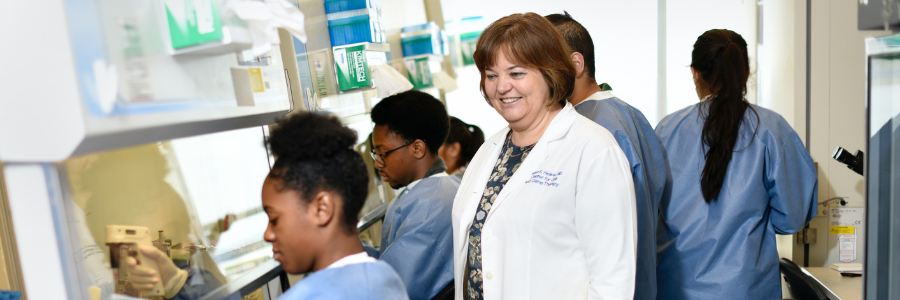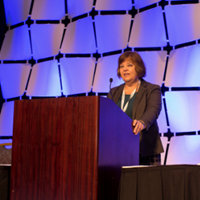Five Questions with Helen Heslop, M.D., for International Women’s Day
Catherine Gillespie - March 08, 2021
In our first interview during Women's History Month, we talked to ASGCT Past President Helen Heslop, M.D., about the importance of mentorship for women in science.

In honor of International Women’s Day on March 8, ASGCT is discussing excelling in the male-dominated world of science with female leaders in cell and gene therapy. To begin Women’s History Month, we asked Helen Heslop, M.D., DSc. (Hon), about how mentorship shaped her career and the path that led her to her current position of director of the Center for Cell and Gene Therapy and interim director of the Dan L. Duncan Comprehensive Cancer Center at Baylor College of Medicine.
How would you say gender has influenced your career path?
I was always told I could do whatever I wanted to because my mother was a physician-scientist. Actually, my grandmother and great grandmother were university graduates. My great grandmother was the first female at the University of Canterbury in New Zealand, so it was always a tradition. I think at home that was always the case.
How would you describe the importance of mentorship in your career trajectory?
In terms of mentorship, when I was a resident and a fellow there were not that many females in the positions that mentored me. If I think about my major mentors in New Zealand and even in England, they are all male. I will say, I worked with some male mentors who were very supportive to women trainees. Mike Beard in New Zealand and Malcolm Brenner in England. If I was talking about female mentors, I’m more talking about colleagues and we sort of mentored each other rather than the more senior mentor. I actually think mentoring is vertical and lateral, so you’ve got people who are your colleagues and as you get older, your junior faculty mentor you. I would say Clio Rooney mentored me a lot in learning about Epstein Barr Virus. I talk to Peggy Goodell a lot about political things. I would say Rayne Rouce has mentored me about diversity. I think it goes all sorts of different ways.
I actually think mentoring is vertical and lateral, so you’ve got people who are your colleagues and as you get older, your junior faculty mentor you.
Helen Heslop, M.D.
How have particular obstacles that have come up in your career shaped your role in the field?
I was talking to one of my mentees today who was making plans for her future career and I was saying, I was told on my first day of internal medicine that I had to make five-year plans. And sometimes they kind of worked out, especially early on. I was going to do internal medicine then hematology. But sometimes serendipity comes in. If you told me when I was a first-year resident in Christ Church, New Zealand that I would end up in Houston, Texas, I would have thought you were completely crazy. The way I got here was sort of serendipity and I think taking advantage of opportunities I wouldn’t have expected. You’ve got to be prepared that you might get opportunities you are not expecting, and you’ve got to look at them and decide when you take them and when you don’t. As I’ve gone through my career, I’ve had some opportunities that I’ve ended up taking and others where I’ve decided that’s not what I want to do. You want to have the ability when you get an opportunity to really look at both sides of it and work out if it’s the right one for you.
In terms of barriers, I was talking to someone at Baylor yesterday about how there are no female clinical chairs. If you look around the basic science chairs meetings, I would say most of the time in the meetings it is almost 50/50. But when I go to the clinical chairs meeting, there used to be a female chair of anesthesiology, but now there are no female chairs. I’m the main clinical center director so unless the ethics director comes I’m the only female. Sometimes I look around and I think this shouldn’t be the case in 2021.
How would you describe mentorship “best practices” when it comes to your own style of mentoring junior women?
When you have mentors, and they do a good job, you try to mentor the things that are successful. I would say the thing that is most helpful is asking people what they want to do and guide them in how they get there but let them make their own decisions. Making sure that people work through a decision and know that it is the right one. You know, I talked a lot to Cath Bollard when she was looking at going back to New Zealand. I didn’t ever tell her to go or not to go, but she ended up making the decision to go to Washington, D.C. instead. You can ask her whether that was the right decision. (According to Dr. Bollard, it was "definitely the right choice." You can learn more about her career path in an upcoming Women's History Month interview on our blog.)
You’ve got to be prepared that you might get opportunities you are not expecting, and you’ve got to look at them and decide when you take them and when you don’t.
Helen Heslop, M.D.
I think being transparent and accessible, but also it is important that mentoring goes two ways. It can be just the satisfaction of seeing people move to their own leadership positions is satisfying, like Drs. Bollard, Stephen Gottschalk, Barbara Savoldo. Or it could be hearing about how the younger generation is thinking in the lab and their perspective on things.
The other thing I would say is that you need multiple mentors, some of whom may be more senior, some at your level, some may be junior because you really need to be mentored in lots of different areas and no one person can provide everything. As a mentor you have to know when you’re not providing everything a mentee needs and you can let them know they need to get another person to provide a certain kind of mentorship that they need.
What do you see as ASGCT’s role in promoting strong mentorship or furthering opportunities for networking among women in science?
 I think one of the good things about transplant and cell therapy is that the meetings are still relatively small, so you do meet people, and you can have people who are not in your department or division who you can consider mentors. ASTCT does a clinical research training course. I know a lot of people who have gone to that have acquired mentors at other places that they interact with. At ASGCT we have talked about doing a similar sort of week-long meeting for young investigators. Probably with Zoom it could be easier to set something up, too. I think perhaps having female leaders in the field available if someone from another center wants to talk to them or get advice a little bit removed from their own place, just looking at things from a slightly different angle.
I think one of the good things about transplant and cell therapy is that the meetings are still relatively small, so you do meet people, and you can have people who are not in your department or division who you can consider mentors. ASTCT does a clinical research training course. I know a lot of people who have gone to that have acquired mentors at other places that they interact with. At ASGCT we have talked about doing a similar sort of week-long meeting for young investigators. Probably with Zoom it could be easier to set something up, too. I think perhaps having female leaders in the field available if someone from another center wants to talk to them or get advice a little bit removed from their own place, just looking at things from a slightly different angle.
I certainly know that for people I’ve mentored they usually have two or three other mentors, either within the Center for Cell and Gene Therapy or even outside. It is important because you might model yourself after different people for different sort of scientific or clinical mentoring, or even work-life balance. I’m probably not a good person to advise on work-life balance, for example.
Read our pieces on Catherine Bollard, M.D., Vivian Choi, Ph.D., and Maritza McIntyre, Ph.D.
Ms. Gillespie is a senior scientific editor for the Center for Cell and Gene Therapy at Baylor College of Medicine and a member of the ASGCT Communications Committee.